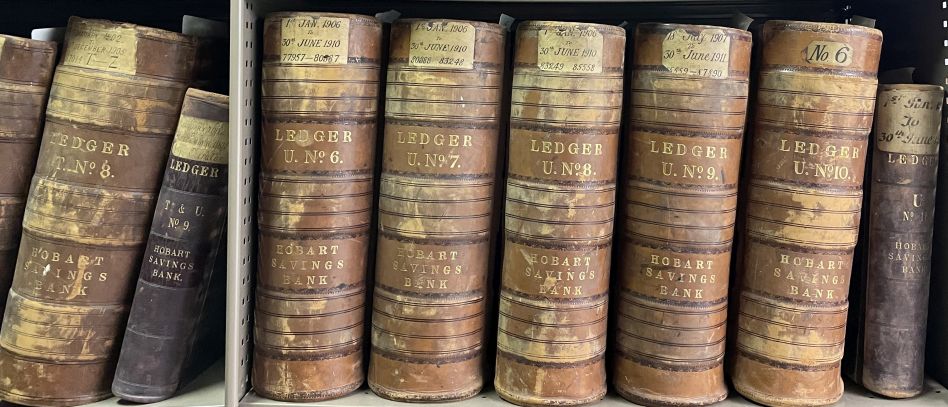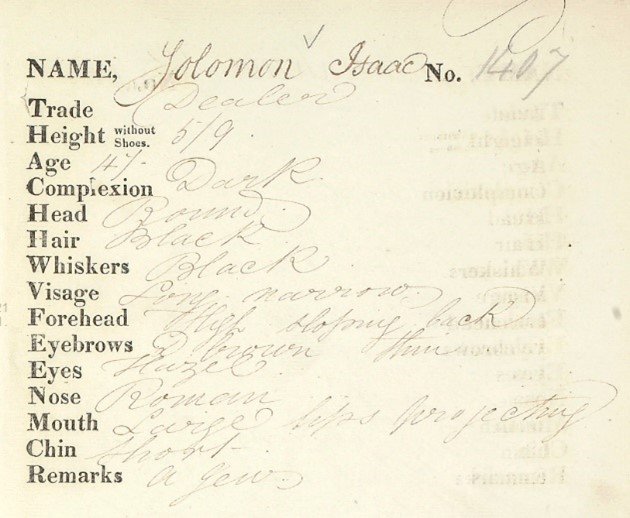Tasmania Reads: Reading a Convict Record (Part Two: The Answer and Historical Background)

The State Library and Archive Service is issuing a challenge to Tasmanians to read five different examples of nineteenth-century handwriting from our Heritage Collections, each featuring a different set of records held in the State Archives.
Just to recap:
Your Transcription Challenge
Your second challenge is to transcribe the conduct record of Isaac Solomon. The information in this section of the conduct record was mostly self-reported by convicts on their arrival to Van Diemen’s Land during the assignment period (pre-1840).

This section of the convict record is in the top right-hand corner and usually included what the convict was transported for, their gaol report, the hulk report, marital status, what offences the convict stated they were convicted for and former convictions and the Surgeon’s report.
Hint: Convict records, commonly used abbreviations.
The Answer
Transported for receiving stolen goods Gaol report Before transported Hulk report Married 5 children Stated this offence Received stolen goods transported about 20 years ago for a pocketbook Pardoned in 3 or 4 years afterwards as Moses Joseph was sent to Sydney for the same Offence Wife and family in this Colony. Married six children.
Historical Background: Who was Isaac Solomon?
This is the conduct record of Isaac Solomon who was transported on the William Glen Anderson in 1831. Isaac Solomon, more frequently known as Ikey Solomon, is widely believed to be the inspiration for Dickens character of Fagin in Oliver Twist. Fagin was of Jewish descent as was Ikey Solomon. Fagin is an anagram of the Yiddish word for thief, ganif.
Dicken’s portrayal of him has been described as, “one of the most notorious antisemitic portraits in English literature.” In Oliver Twist he describes Fagin as a very shrivelled old Jew, whose villainous-looking and repulsive face was obscured by a quantity of matted red hair. (Dickens, Oliver Twist, p42)
Author Bryce Courtenay continues in a similar vein – extending his insults to include Ikey’s wife Ann in The Potato Factory. Courtenay describes Ikey and Hannah Solomon as creatures of the dark hours, dirty furtive and predatory – who are so consumed by greed and hate that they are unable to form meaningful relationships or make a go of it in the new colony.

In her court appearance at the Old Bailey in 1827 where she was convicted of receiving stolen goods, his wife Ann was described as dressed elegantly. She was sentenced to be transported to Van Diemen’s Land and arrived on the Mermaid in June 1828, aged thirty-five.
There can be no doubt that Ikey was a very successful career criminal. He was charismatic and this along with his wealth, made him many friends, both male and female, with many in positions of authority and influence. Some writers say he was probably a member of the Masonic Society, and as such would have been protected by that society. He was at the height of his career one of the richest men in London, and credited by the popular press as the Prince of Fences, and a notorious receiver
The story of Isaac Solomon and his family is a fascinating one, and it has been written many times. T. Garth Hyland writes a fictionalised and well researched account of Ikey Solomon’s life and adventures that’s intertwined with his own family history in Thanks a lot, Guv! and John S. Levi & G.F. J. Bergman devote a chapter to him in Australian Genesis: Jewish convicts and settlers. The chapter is tellingly titled, “Fagin in Australia”.
The First Fagin: the true story of Ikey Solomon, by Judith Sackville-O’Donnell is the most recent account held in the State Library of Tasmania’s collection. Published in 2002 it aims to be a corrective to the harsh portrayal of Fagin and Ikey in fiction. Sackville -O’Donnell claim that it’s also a love story. Sackville-O’Donnell’s version has been made into a DVD also titled, The First Fagin that it seamlessly blends reconstructed dramatic sequences with historical documentary.
J.J. Tobias’s book follows on from his BBC radio series on Ikey. He has made a career of writing on crime and police in England. Tobais’s publication “Prince of Fences: the life and crimes of Ikey Solomon” draws on the official records of the Tasmanian State Archives and the Public Records office of London.
There are lending copies of all books and the DVD for you to enjoy so I’m not going to give you the full story here.
If you decided you wanted to write your own version of the Ikey Solomon story – what angle would you take? Would it be a tale of anti-semitism, a love story, a true crime documentary, an account of life and crime in London in the early 19th century, an expose of Governor Arthur’s convict system where wealthy and skilled convicts were treated differently? Or might it be an expose of the wealthy and influential contacts Ikey had in VDL in arrival, or perhaps a tale of how Jewish people survived in early Australia?
As well as the books and DVD mentioned previously you can also access the multitude of archival records held on the Solomons.
Search our catalogue for Archival records and Names Index records for Ikey. Most of the records for Ann are included with Ikeys. But here are the links to her own convict records: Ann Solomons (sic)
We also have a very extensive research file that will give you access to many other records and newspaper accounts. If you are interested in the research file, submit a research enquiry ask for Isaac Solomon’s research file and we will send you a summary of the contents with instructions on how to obtain copies.
Bibliography
Tasmanian Archive Sources
Convict Department, Conduct Registers of Male Convicts Arriving in the Period of the Assignment System CON31/1/39 page 161
Convict Department, Description List of Male Convicts, CON18/1/21 Image122
State Library Sources
We hold many different formats and versions of these two publications
Bryce Courtney, The Potato Factory
Charles Dickens, Oliver Twist
T. Garth Hyland, Thanks a lot, Guv! : the stories of John Ireland (Hyland) & Harriet James, James & Sophia Gunyon, James Britton, William Heard (Hurd), Isaac (Ikey) & Ann Solomon, Sandy Bay, T Garth Hyland c.2004
John S Levi, and G.F.J. Bergman, Australian genesis : Jewish convicts and settlers, 1788-1860, Carlton South, Vic, Melbourne University Press, 2002
Judith Sackville-O’Donnell, The first Fagin : the true story of Ikey Solomon, Melbourne, Acland Press, 2002
Helen Gaynor, The first Fagin [DVD] written and directed by Helen Gaynor, Alan Rosenthal, Canberra, A.C.T. Ronin Films, 2012
Newspapers accounts
“Ikey Solomons, his apprehension, and transmission to the country for trial.”, Morning Chronicle [newspaper], July 10, 1829, London, England
Old Bailey”, Examiner [newspaper], December 12, 1824, London, England
Additional Reading
P.R. Eldershaw, Guide to the Public Records of Tasmania, Section three, Convict Department, Hobart, Tas. Archives Office, 1965
Susan Hood, Transcribing Convict Records, Port Arthur Tas, Port Arthur Management Authority, 2003.


Fascinating story Elizabeth, and I love how you have made the connection to the State Library records on Ikey, thank you.
Hi, I am a UTAS student and working through transcribing convict records. Is there a list of commonly used shortcuts that you can recommend? I have managed to get about 80%, but continue to be struck on the following highlighted in ?????
June 7 1838 Chain gang absconding Port Arthur
June 7 1839 Chain gang misdemeanour, 7 days cells Bread & Water / WE & H Nicholls/
March 5 Striking a fellow prisoner whilst at work 30 straps / Pa ?????
Septr 21 & public works. Misconduct in pilfering some flour from the stores at Bridgewater cell on Bread & Water 4 days / I W B???
Nov 10 Bridgewater / neglect of duty one month hard labor out of chains TM/TS???? out of chains conduct to be reported to PS??? Vide Lieu Govr Decision 29 Nov 1839
Transcribing Tasmanian convict records by Susan Hood is our best resource, you can find copies in our libraries here: https://libraries.tas.gov.au/Record/Library/SD_ILS-696138
The photograph described above as presumably of Ikey Solomon outside his shop, in fact shows William Legrand, bookseller outside this shop, which he tenanted between 1866 and 1880. (Some of his book stock can be seen through the shop’s front window.) I have explored the history of this little building within my doctoral thesis on Legrand (“William Legrand: A Study”, of which the Tasmanian Archives has both DVD & a paper copy). The same photo stated above to be of Solomon was listed in the Allport collection as “Winter, Alfred. W. Legrand Booksellers Shop, Next Robb’s Saddler, Elizabeth St. [18–]. Allport Library & Museum of Fine Arts, Tasmanian Archive & Heritage Office.” As a matter of interest, Ikey Solomon died in September 1850, when photography was not at the advanced stage demonstrated in this work by the talented Alfred Winter. I hope it will be possible for the incorrect information currently displayed on this online article to be amended
Thank you very much for bringing this to our attention. We have forwarded it to our Collections team to investigate and make any necessary changes.
Do you know where in Elizabeth St the shop was located?
Hi Michelle. We think it is probably 97 Elizabeth Street. The upper storey of the building nextdoor has a sandstone facade that has survived and appears to be a good match.